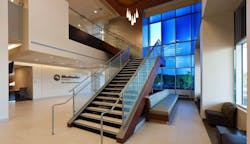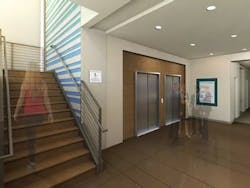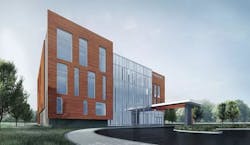Can 'active' building designs make people healthier?
The phrase “environmentally conscious design” typically conjures images of recycled materials and energy efficient systems for lighting and temperature control. Methodist Olive Branch Hospital, which my colleague David Zegley has already discussed in a previous post, is one great example. Today, we’ll focus on another – the 25,000-square-foot (and LEED Gold projected) medical office building GS&P recently designed for Kaiser Permanente in Anne Arundel County, Maryland.
Designed to house everything from primary care, obstetrics and pediatrics to optometry, a pharmacy, imaging and laboratory services, this MOB embodies the connection between between healthy building techniques and a healthier world. With careful planning and client guidance, we drastically improved the facility’s environmental impact by reducing its total water/energy consumption, carbon footprint, and demand for construction materials.
Energy model calculations project the building to perform 34.6% better than AHSRAE 90.1 standards, the benchmark for energy consumption building codes across the U.S. Water consumption will be more than 30% lower than federal government standards, and regionally sourced materials with high-recycled content and low VOC emissions will promote a healthy and inviting interior environment.
But this high-performance building also incorporates another important aspect of environmentally conscious design that often gets overlooked: using the built environment to improve the overall health of its occupants.
A Growing Health Issue
According to the Centers for Disease Control and Prevention, nearly half of Americans do not get enough daily exercise to meet the government’s minimum guidelines for aerobic physical activity. In Maryland, the adult obesity rate has nearly tripled to 29.6% since 1990 while heart disease accounts for nearly a quarter of all deaths and is the leading cause of mortality at both local and national levels. Stroke and diabetes also rank among the top causes of death nationally and in Maryland.
Because adequate physical activity can reduce the risk of all four of these health issues the U.S. Green Building Council has introduced a pilot credit for LEED certification focused entirely on occupant health and physical activity (EQpc78 – Designing for Active Occupants). This concept played a central role in the interior space planning exercises we conducted during the schematic design phase of the new MOB in Anne Arundel County. As we examined the possibilities, we found that very simple changes in the spatial hierarchy and natural progression of the public spaces would provide occupants with an equal opportunity for healthy choices.
These changes to the way we envision our built environments can have a major impact on whether people live an active or sedentary lifestyle. In the case of Kaiser Permanente’s new medical office building, two distinct design factors play the most prominent roles in promoting physical activity.
Stair-Centric Design
The average annual weight gain for adults in the U.S. is about one pound per year, which adds up quickly as the years go by. Fortunately, climbing the stairs for just two extra minutes per day burns enough calories to cancel out the extra pounds. However, stairs in modern healthcare and office buildings often feel like an afterthought. Especially when they get tucked away in dark, low-traffic areas, those “emergency exit” signs can start to feel like they really say “emergency only.”
Here, we brought the stairs out into the open and made them feel like a central part of the building’s circulation system. The main staircase (which doubles as a fire exit) spills directly out into the entrance lobby, an expansive space flooded with natural light. A custom dimensional feature wall begins to engage sensory elements in an exciting way. Natural and artificial light fill the stair core and provide a comfortable level of light for travel and safety. Equal visibility and prominence with the elevators make the stairs an appealing option for everyday use by both visitors and staff. Another set of stairs at the opposite corner of the building, an area vital to employee travel and not served by an elevator, creates a convenient vertical connection between the 2nd and 3rd levels.
Alternative Transportation Options
Another way to quickly promote physical activity among building occupants is by making it easier for them to leave the car at home. In this case, a high-volume bike rack located just outside the main entrance fosters awareness among passersby that riding a bike to their destination is a viable option. Summers in Maryland can get hot, of course, so a public water cooler and a shower/changing facility provide cyclists an opportunity to “freshen up” upon arrival if necessary.
Sustainability isn’t just about the environment anymore. Design leaders must begin to harness the synergy between healthy people and healthy environments, which is why bike storage, changing rooms, and stair-centric designs that encourage physical activity now factor into LEED certification scores. At GS&P, we think carefully about how the spaces we design can encourage people to live healthier, more active and more sustainable lifestyles. What better way to do that than by designing the very structure of a healthcare facility to promote healthy choices?
About the Author: Terrance Perdue is an Intern Architect in GS&P’s Nashville Design Studio and has worked on a variety of healthcare projects since joining the firm in 2015. As a young professional and LEED AP BD+C, he brings a passion and excitement to the dialogue surrounding high-performance building within the office. He hails from Jacksonville, Fla., and earned a Master of Architecture degree from Ball State University after graduating with a Bachelor of Design in Architecture from the University of Central Florida.


